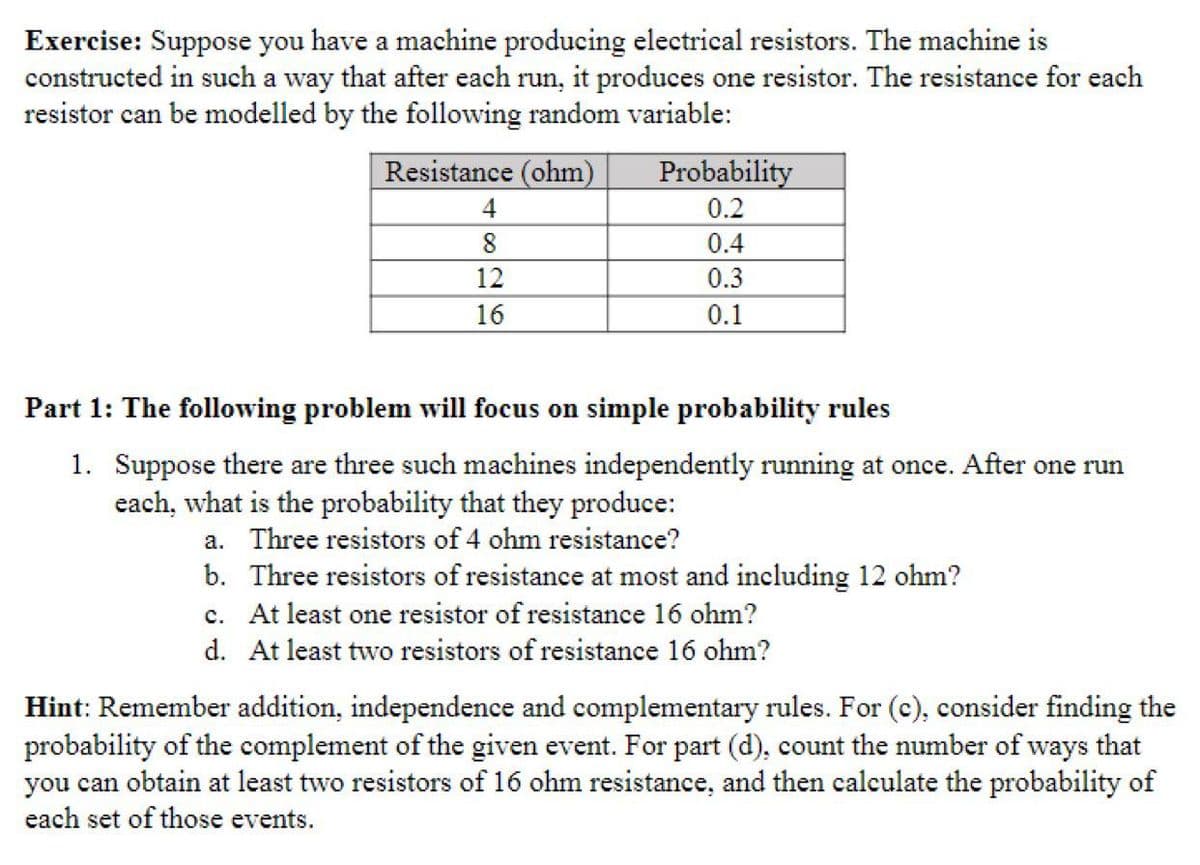Suppose there are three such machines independently running at once. After one run each, what is the probability that they produce: a. Three resistors of 4 ohm resistance? b. Three resistors of resistance at most and including 12 ohm? c. At least one resistor of resistance 16 ohm? d. At least two resistors of resistance 16 ohm?
Suppose there are three such machines independently running at once. After one run each, what is the probability that they produce: a. Three resistors of 4 ohm resistance? b. Three resistors of resistance at most and including 12 ohm? c. At least one resistor of resistance 16 ohm? d. At least two resistors of resistance 16 ohm?
Holt Mcdougal Larson Pre-algebra: Student Edition 2012
1st Edition
ISBN:9780547587776
Author:HOLT MCDOUGAL
Publisher:HOLT MCDOUGAL
Chapter11: Data Analysis And Probability
Section11.8: Probabilities Of Disjoint And Overlapping Events
Problem 2C
Related questions
Question
I need the answer as soon as possible

Transcribed Image Text:Exercise: Suppose you have a machine producing electrical resistors. The machine is
constructed in such a way that after each run, it produces one resistor. The resistance for each
resistor can be modelled by the following random variable:
Resistance (ohm)
Probability
0.2
8
0.4
12
0.3
16
0.1
Part 1: The following problem will focus on simple probability rules
1. Suppose there are three such machines independently running at once. After one run
each, what is the probability that they produce:
a. Three resistors of 4 ohm resistance?
b. Three resistors of resistance at most and including 12 ohm?
c. At least one resistor of resistance 16 ohm?
d. At least two resistors of resistance 16 ohm?
Hint: Remember addition, independence and complementary rules. For (c), consider finding the
probability of the complement of the given event. For part (d), count the number of ways that
you can obtain at least two resistors of 16 ohm resistance, and then calculate the probability of
each set of those events.
Expert Solution
This question has been solved!
Explore an expertly crafted, step-by-step solution for a thorough understanding of key concepts.
Step by step
Solved in 2 steps with 2 images

Recommended textbooks for you

Holt Mcdougal Larson Pre-algebra: Student Edition…
Algebra
ISBN:
9780547587776
Author:
HOLT MCDOUGAL
Publisher:
HOLT MCDOUGAL

Algebra & Trigonometry with Analytic Geometry
Algebra
ISBN:
9781133382119
Author:
Swokowski
Publisher:
Cengage

College Algebra
Algebra
ISBN:
9781305115545
Author:
James Stewart, Lothar Redlin, Saleem Watson
Publisher:
Cengage Learning

Holt Mcdougal Larson Pre-algebra: Student Edition…
Algebra
ISBN:
9780547587776
Author:
HOLT MCDOUGAL
Publisher:
HOLT MCDOUGAL

Algebra & Trigonometry with Analytic Geometry
Algebra
ISBN:
9781133382119
Author:
Swokowski
Publisher:
Cengage

College Algebra
Algebra
ISBN:
9781305115545
Author:
James Stewart, Lothar Redlin, Saleem Watson
Publisher:
Cengage Learning